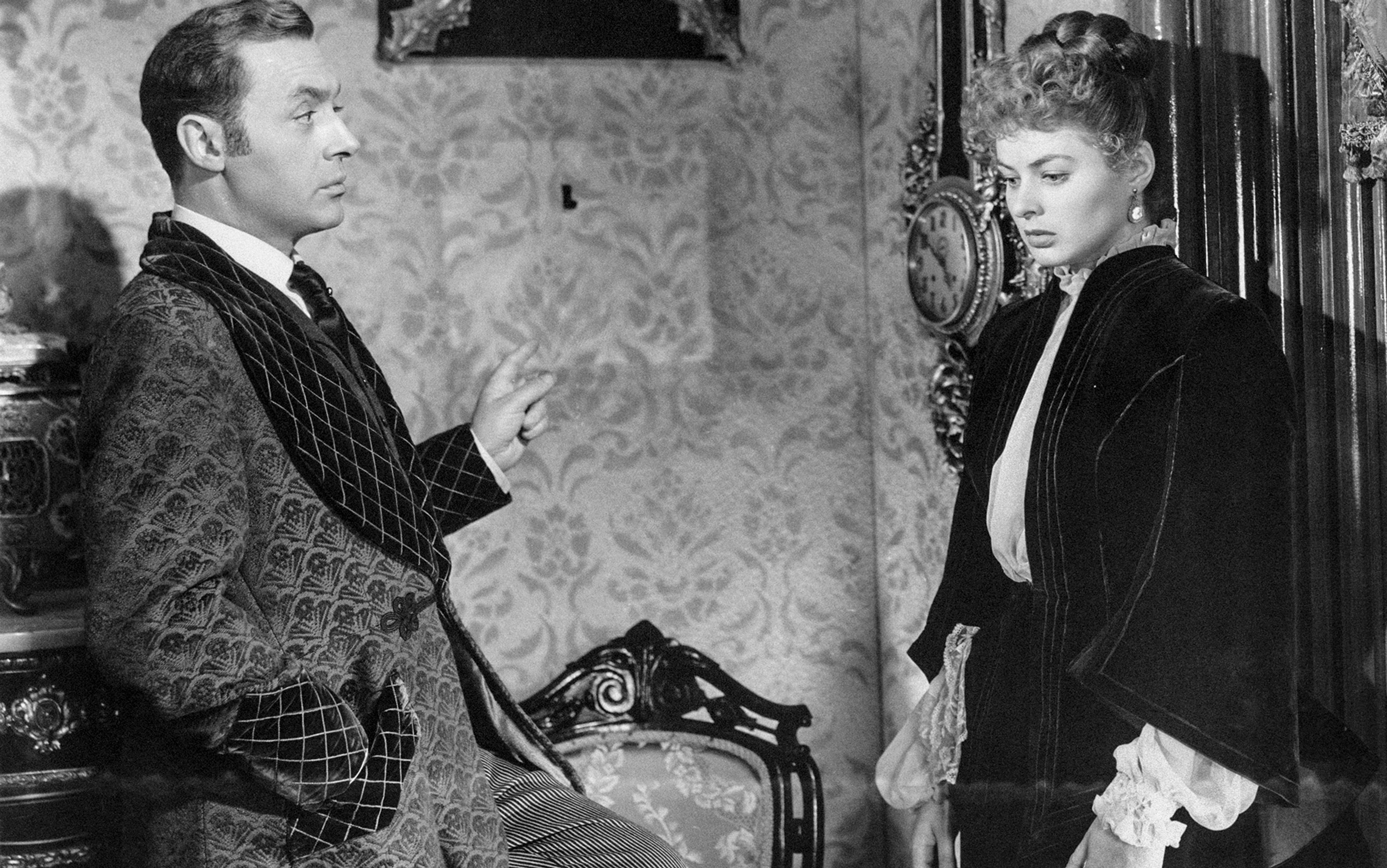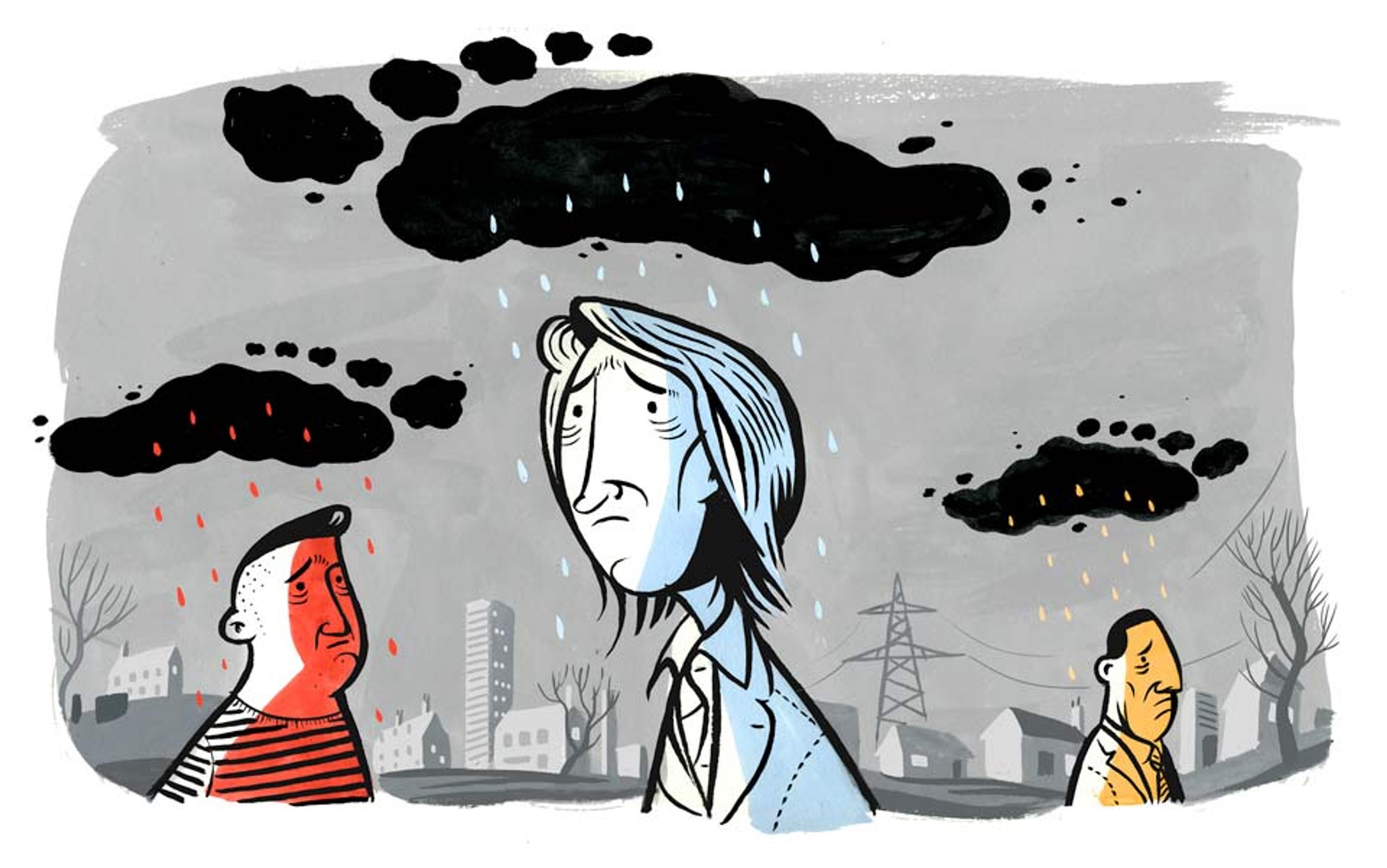‘He didn’t mean anything by it, stop making such a big deal out of it.’
‘Here, let me take care of it, you don’t know what you are doing.’
‘You’re too sensitive.’
‘Stop overreacting.’
‘You keep imagining things.’
‘That’s not how it happened.’
‘Your memory seems to be slipping.’
Such comments undermine our trust in ourselves and our belief in what we know. More than that, they trespass on our sense of identity. The more we hear such phrases, the more we stop trusting ourselves. When another person becomes a gatekeeper to our reality, then we’re in a precarious spot – vulnerable to further manipulation and control. This reality-doubting is called ‘gaslighting’.
As a psychologist in practice, I often see my role as the person who turns off the gaslights. I work with survivors of relationships with high-conflict, antagonistic, rigid, entitled, dysregulated people. These might be their partners, parents, adult children, siblings or colleagues. Once we remove the gaslight, and the house lights come on, my clients recognise that this one difficult person in their lives was the tip of a dysfunctional iceberg.
The term gaslighting derives from theatre and film. Patrick Hamilton’s play Gas Light (1938) was adapted as the British film Gaslight in 1940 and the American classic of the same name in 1944. To this day, Gaslight, a reference to the flickering gaslights featured in the drama, remains a masterclass on how one predatory partner captivates and then slowly undermines the other.
The play and films introduced the term ‘gaslighting’ into our vernacular to refer to a specific type of manipulation – one in which a person’s reality itself is hijacked by another. This can also be manifested by minimisation, deflection, denial and coercive control. The term is now ubiquitous, and we apply it not just to close relationships but also to any reality-bending that is generated by institutions, media and leaders. The genius of the films was to remind us that gaslighting is actually a grooming process, not just a singular event. It’s a process of establishing and then exploiting trust and authority to achieve an endgame of control and dominance.
The backstory (spoiler alert) is the murder of a famed London opera singer. The murderer fails to leave with the jewels he’s come for because he’s interrupted by the victim’s niece, Paula (played by Ingrid Bergman). Years pass, and Paula meets Gregory (Charles Boyer), who unbeknown to her is the murderer. They marry after a quick courtship, and he insists on moving back to the house where the murder occurred, slowly manipulating her reality, including the flickering lights, all with the intent of retrieving the jewels, at last.
In Gaslight, we witness the architecture of abusive relationships. These are relationships that proceed too quickly, too intensely – ‘she was swept off her feet’. Paula was primed to miss the red flags because she’d endured the traumatic loss of her beloved aunt and, upon returning to London, was living in a space associated with grief. Gaslight also shows us the danger of romanticising behaviours such as showing up out of nowhere and surprising a new partner, of insisting on spending time with her alone and creating their own little world together, which can be harbingers of more insidious abusive relationship dynamics such as stalking and isolation. The relationship creates a dynamic in which it is simpler and safer for Paula to doubt herself than to question him.
A therapist bears witness and validates the pain of her clients, hoping to engender insight, change, and the ability to steer one’s own life. I have spent decades turning off the gaslights that flicker and glow in my client’s lives. They experienced the denial of childhood trauma by parents and family, or the invalidation of controlling spouses who acted as judge and jury on their emotional states. My clients have been told by another person or persons how they feel for so long that they no longer feel able to identify their own emotions. To work with clients being gaslighted means dismantling childhood and religious teachings, societal frameworks and cultural codes of conduct. Year after year, I listen to stories of ‘wonderful’ childhoods that devolve into a Eugene O’Neill play under the harsh glare of sunlight and therapeutic interpretation.
Where this struck me most was in working with clients who have endured gaslighted marriages for 20 years or longer. (My specific focus is in an area called narcissistic abuse, a phenomenon whereby people become riddled with self-doubt, anxiety and confusion after being in a relationship with an unempathic, entitled, arrogant, egocentric, manipulative partner, family member or other individual.) These were marriages littered with a range of patterns including control, infidelity, a malignant neglect, deceit, an adult life spent having their realities and voices erased.
To watch a client come out of gaslighting is to witness someone come back into their own
There was the moment in therapy, when the word ‘abuse’ would come out of my mouth, and the reactions were almost universal:
‘Abuse, no, that’s not me, it was just difficult, in fact, I think maybe my expectations were too high.’
‘He only pushed me once, we were both really mad.’
Over the years of their marriages, the self-gaslighting started to become reflexive. My clients fell into the propaganda that they termed marriage, and a chorus of enablers allowed them to maintain the delusion and the illusion. Once the word ‘abuse’ entered the conversation, a transformation occurred, a new narrative entered the room.
Some would terminate therapy. They would say: ‘Thank you for returning my reality to me, but I won’t leave the relationship, and now I understand I was fighting the wrong battles.’ Others used the therapeutic validation as a call to arms, once the gaslight was turned off, once they no longer fell into the narcissist’s reality, the mortar went out of the bricks of the relationship and, the next time the partner threatened divorce, they smiled and said ‘Sounds good.’
To watch a client come out of gaslighting is to witness someone come back into their own (or come into it for the first time). But I also witnessed clients become isolated. Nobody around them wanted to hear about it, and they would often face gaslighting outside of their marriage. ‘Are you sure it happened that way?’ or ‘That’s just your version of the events.’ They were rarely told that their reality was valid. Many of them were looking for a simple benediction that would strengthen their resolve. However, I wasn’t just seeing this in marriages. My clients who experienced abuse in childhood were still hearing family members tell them in adulthood: ‘Just let it go, he’s dead, and far worse abuse has happened to other people.’ The gaslighting of childhood was sustained in adulthood and made the trauma far more difficult to release. These lights can flicker for a lifetime.
Deconstruction of gaslighting as a concept is something that philosophers have done better than psychologists. Recent papers by Andrew Spear (2019) and Kate Abramson (2014) addressed this phenomenon through a dispassionate lens, and proposed that gaslighting is a multistep process of indoctrination. It is comprised of initially drawing in a target; establishing trust and authority (or capitalising on existing trust – for example, a family member or a spouse); slowly dismantling that person’s sense of trust in herself through doubt and questioning or by manipulating elements of the physical environment (eg, moving or hiding objects – and then denying it); eroding a sense of self-trust and self-knowledge in the victim so the victim is less likely to doubt the gaslighter’s word; and finally winning over the victim’s agreement with the gaslighter’s reality. Ultimately, this robs the victim of his or her autonomy and cements the victim’s ongoing consent.
Traditional conceptualisations of gaslighting focus on the emotional abuse inherent in doubting a person’s reality with a goal of destabilising the victim. This isn’t just about the gaslighter’s need for control and capitulation, but their need for consent. The ultimate ‘agreement’ of their victim renders a picture of the relationship to the world that looks consensual and cooperative. The impact of gaslighting is most acutely observed in cult members or others who seem brainwashed – they espouse agreement with the tenets of the cult leader, and over time it appears as though the views of the cult are their own. Once that kind of agreement and acceptance are issued, it is far more difficult for the victim to exit from the situation or relationship.
There is a menacing simplicity to the gaslighter’s motivations – by and large, they appear to be motivated by power and control, which is likely a compensatory offset of their own sense of insecurity. Gaslighters project their own insecurity onto their victims and magnify any insecurity that their victims already have. To achieve this, weakening the resolve of the victim becomes essential. Gaslighting in many ways is the pathologically insecure preying upon the conventionally insecure, with the difference being that the gaslighter is motivated by something more malevolent (power) while the victim’s ordinary insecurity positions him or her to accept the seeds of doubt being sown. The paths to insecurity for the gaslighter and the gaslighted might be quite similar – family legacy issues including invalidating parents, trauma and inconsistency, as well as societal and cultural messages.
Despite these common exposures, the gaslighter alone has internalised the need to dominate; the gaslighter’s insecurity is a diseased state that can be silenced only by their own rage or control. When I call out gaslighters in therapy, their defensiveness erupts, the fragile ego is exposed, and that rage intrudes. It is a painful insight into the challenges that the people who live and work alongside the gaslighter experience daily.
Sadly, the romanticisation of dependency within a relationship also facilitates gaslighting. The gaslighter will often reassure and communicate caregiving, as in ‘Let me take care of things.’ The gaslighter might subtly deny the victim’s abilities: ‘Are you sure you can manage doing this?’ Not only does the seed of doubt get planted, it builds upon existing insecurities in the victim (‘Maybe I can’t manage everything, I’m really disorganised’) and plays upon the childlike fantasy of someone sweeping in and making everything OK.
The less egalitarian a relationship, the more vulnerable it is to gaslighting
I have worked with numerous women who were successful professionals in their own right, with careers in engineering, medicine, law, academia or business. Even then, the slow programming that characterises gaslighting undercut those very women who seemingly held societal and economic privilege. This happened in both heterosexual and same-sex marriages. The birth of a child meant that staying at home gradually became acceptable. The gaslighters’ self-proclaimed financial ‘savvy’ meant it ‘made more sense’ for them to manage the money. Such isolation and subtle shifts in power create a crucible for gaslighting.
When I sat in therapy with these women and we did the postmortem, I was able to point out how their subtle indoctrination was framed as ‘caregiving’, making it more sinister, and leaving my clients with a sense of shame and self-devaluation. And among those clients who had far less societal power, or were already financially dependent on a partner, the gaslighting proceeded with greater alacrity because the dependency fostered the dynamic.
It’s a systematic process and death by a thousand cuts. The first gaslighting statement isn’t what breaks us down – it’s the accumulation: months or years of minimisation, invalidation, undermining, deceit, chequebooks being hidden, items being moved, your abilities being doubted, your feelings being trivialised.
Relationship gaslighting doesn’t occur in a vacuum. Societal structures – authoritarianism, patriarchy, marriage – foster fertile ground for this phenomenon. These are constructs and models that are characterised by the cultivation of blind and unearned trust in leadership, in the patriarchy, in the more emboldened spouse or parent. The less egalitarian a relationship, the more vulnerable it is to gaslighting.
Gaslighting is far more complex than lying – though lying is part of the gaslighting framework. The liar simply lies, but the gaslighter doubles down on lying and not only lies but engages in a projective denial that solidifies the gaslighter’s power because they focus on the ‘confusion’ or ‘impairment’ or ‘madness’ of the victim rather than their own deceptive behaviour; it’s the classic street con of a perpetrator creating a distraction so an accomplice can lift your wallet. This isn’t a discussion about the ‘evidence’ but rather a dismantling of the victim – a slow dissembling of their sanity, memory, feelings, reality and identity. The psychiatrist Theo Dorpat in Seattle described gaslighting through the framework of a ‘double whammy’, with the gaslighter verbally assailing the victim, and then following that up with statements designed to undermine the person’s confidence in self. You knock them down and then break them down so they can’t get back up. The gaslighter doesn’t just manipulate a person’s reality: they also manipulate a person’s identity.
And this is just the first level of assault. Gaslighting escalates. If sowing seeds of doubt, generating confusion and shutting down the victim so they can’t be autonomous or voice an opinion don’t work, then the gaslighter will start using the ultimate weapon.
Abandonment.
Fear of abandonment evokes deep feelings of alienation, ostracism and exclusion, and plays out against the backdrop of early childhood attachment issues. So it makes sense that, in the big bet, the manipulative Hail Mary pass, the gaslighter offers a contorted ultimatum. ‘Well, since we can’t see eye to eye, maybe we shouldn’t be together … maybe you don’t need me to take care of you … maybe we should get divorced.’ Then, in order for victims to maintain the relationship, there is, at first, capitulation, then a denial of feeling, and then a slow indoctrination into agreement with the gaslighter’s reality.
Gaslighting has always been a part of an intimate relationship structure characterised by power differentials. In general, the person with more privilege and power in the relationship is in a better position to gaslight. In heterosexual relationships, the greater power of men within most societies has meant that gaslighting by a male partner would be easier and more likely because there would be a greater presumption of authority and knowledge by a man. However, that’s not to say that a female partner can’t gaslight – they can, and do. Within any given relationship structure, authority and superiority can be grabbed up just on the basis of entitlement, and even the ostensibly ‘less privileged’ partner can gaslight by fostering a sense of trust, generating confusion and then angling for consent.
The dynamic cuts through any human relationship: parent-child, intimate partners, boss-employee, teacher-student, doctor-patient, pastor-parishioner. First there is vulnerability, within a context of presumptive trust. Then power differences fostered by other factors including culture, gender, race, ethnicity, age differences, acculturation and money set the stage.
Gaslighting can be perpetrated by anyone, but it’s really the narcissist’s ground game. The lack of empathy, the entitlement, the arrogance, all set the tone. The natural history of a narcissistic relationship reflects the grooming process for gaslighting – the classical sequence is often one of idealisation and seduction, followed by devaluation and discarding. For victims, a larger-than-life love story, or feeling understood as never before, not only fills holes left by a dysfunctional family but, more importantly, creates the sense of a unique devotion and bond.
This not only fosters trust, but also constrains critical thinking. The primitive craving for trust and safety that trails into adulthood can blind a person to gaslighting. This also raises the potential for cognitive dissonance – the glue of the toxic relationship – where realities conflict. Cognitive dissonance refers to the idea that the human mind doesn’t hold conflicting viewpoints well, so we justify and rationalise uncomfortable choices to generate our personal buy-in (the classical example of this is Aesop’s fable about the sour grapes). The desire for the love story weakens the ability to integrate toxic dynamics such as anger, lying, antagonism and confusion into a more holistic view; the narrative around a happy family makes integrating invalidation and cruelty all but impossible. Thus, the rationalisation: he isn’t controlling me, he just wants to take care of me; I haven’t been sleeping, maybe I am absent minded; my parents focused on working hard to make sure we had a roof over our heads. With such acquiescence, the relationship (and the gaslighting) persists. In my clinical work with gaslighted clients, rationalisation becomes reflexive. Even in the throes of an embittered and expensive divorce, over and over I have observed clients’ attempts to explain the other spouses’ antagonism as being due to their childhood.
A particularly toxic impact of gaslighting is that it reinforces the victim’s compulsion to provide evidence to substantiate their feelings. I know I am working with a client experiencing long-term gaslighting when they say things in therapy such as: ‘I know I have no right to feel this way but, when I show you this text he sent me, it will make more sense.’ My job as the therapist is to let my client know that I don’t need to see the text, and instead I focus on the distortion that they ‘have no right to feel this way’. It is my role to remind them that their feelings are always valid, there are no ‘unjust’ feelings. We then work together to help them dismantle this idea that their feelings require an evidentiary base.
Large institutions that have traditionally been conflated with trust are able to gaslight with ease
Interestingly, we often see gaslighting as an individual phenomenon – one person attempting to control another, but it can happen in other ways as well. Gaslighting can occur by proxy – another person in the gaslighter’s world vouching for them (‘You’re wrong about him, he’s not a bad guy, I have never had any issue with him’). There can also be something I term ‘gaslighting by tribe’ – when an entire group, typically a family, will close ranks and ally with the gaslighter (‘Your father has been a good provider, just let it go’), though this can also happen in workplaces or among friends (‘We’re lucky to work here, don’t be so sensitive about what he says’). When other people validate the gaslighter’s antics, it can fortify the power of this dynamic and leave the gaslighted even more confused. In therapy, I have the luxury of working with clients individually but, when they leave our time together, they’re faced with complex familial networks, and the gaslighting dynamic can be magnified by culture, social class and religion. Each session in therapy feels more like dialysis, a clearing out of the confusing and toxic things they were told; I fortify each client for the subsequent weeks until we can again recalibrate against the collective gaslighting they face.
A parallel process unfolds with any putatively trusted source of information – this can include religious organisations, media, governments, justice systems, educational systems. We’re socialised to trust and obey these systems. In fact, they’re branded on trust and integrity (often unsubstantiated). Individual success is often predicated on adherence to the expectations of these institutions. Blind trust means that, when these systems generate policies, recommendations, information or behaviour that might be out of sync with our reality, the tendency is then to doubt ourselves rather than the intention of the organisation.
We want to trust newspapers, so sometimes it’s hard to believe that they might obscure reality. A religious organisation wouldn’t deny the bad behaviour of its leadership – would it? A president or a prime minister or congress or parliament wouldn’t deny the reality of their constituency – could they? Because a critical mass of the population buys in, large institutions that have traditionally been conflated with trust are able to gaslight with ease. Since so many trusted entities are able to regularly gaslight the population, this emboldens, enables and encourages individual gaslighting. Obedience is baked into education, family and religion – as such, children and then adults never get formal training in how to hold onto their reality. Instead, capitulation is inculcated, setting a precedent and fostering a vulnerability to being gaslighted, especially in those who are disenfranchised and oppressed.
When you really step back, a cynic could argue that all marketing, advertising and persuasion is gaslighting. A perceived authority (a person who is familiar with a product or concept), second-guesses the customer and tries to convince them that they need the object being purchased (you think your car is a good car, but it’s not). The customer then doubts herself, and has more trust in the car seller (who is the expert) and then agrees with him that the expensive car being proffered would improve her life. And upon that consensual agreement, she purchases the car; if the woman had trusted herself and her contentedness with the performance of her reliable old car, the sale might not have been made.
Media, technology, ubiquitous disinformation – all contribute to an atmosphere conducive to gaslighting and its manifestation in confusion and mistruths. But, ironically, technology has also provided a unique tool to help invalidate the gaslighter’s agenda: the cellphone camera and voice recorder. After thousands of years of people’s experiences being questioned, the ability to document the experience in real time has actually elucidated arguments and deceptions that were traditionally rebuffed or minimised. Yet, even when there is recorded proof, gaslighters persist (and instead of copping to the recorded evidence, will often paint a picture of the person who recorded the interaction as paranoid and untrustworthy). Unfortunately, when it comes to tech, it cuts both ways: gaslighters will edit footage and choose to record at moments that support their agenda of an ‘out of control’ partner. The insidiousness of gaslighting ultimately means that it’s difficult to find a workaround, even when you have what feels like ‘evidence’.
What’s striking and troubling is how little has been written about gaslighting in the peer-reviewed psychological, psychiatric or mental health literature. Rigorous studies are scant. This sparse literature tends to be a smattering of psychoanalytic case reports, domestic violence literature, and a handful that use the term to describe systemic or institutional issues. In this literature, much as in the philosophy literature, gaslighting is framed in a surgical, analytic and detached way without much consideration for the abuse behind the process. Where studies highlight manipulation within intimate relationships, they tend to focus on specific situations or groups: elder abuse, sexual coercion, or cases where personality disorders hold sway.
Often, I see clients who felt that previous therapists have been unwilling or unable to make presumptions about the disposition and personality of the gaslighter (who is typically not in the room). People who are being gaslighted can become so undermined that they’re reluctant to seek out therapy; when they finally do, the lack of recognition of gaslighting by the mental health profession in any systematic manner means that there’s a risk that a client might feel gaslighted in therapy. The therapist’s disinclination to ascribe motivation to the words and actions of the gaslighter in their client’s life, and the attempt to analyse only the client’s reactions to their partner’s gaslighting will often perpetuate the gaslighting dynamic, pathologising the client while ignoring the confusion and control wrought by the gaslighter. For instance, a therapist might question why the client doesn’t just leave the invalidating and cruel partner, instead of recognising the confusion inherent in the gaslighting dynamic. Or the therapist will focus on the client’s anxiety rather than also considering the situation generating the anxiety. This is all the more confounding because the term ‘gaslighting’ is well represented in the self-help and non-academic psychology literature, which might speak to an elitist bias against the term, and a disconnect between the issues that mental health ‘consumers’ are trying to understand – and what clinicians know or are willing to discuss.
At the end of Gaslight, Paula plays it out like a pro. Ultimately, what saves her is that one other person saw what was happening and stepped in – usually, that’s all it takes: just one person who bears witness. At the end, she beats her gaslighter by jumping into his narrative and turning it on him. When he’s in the attic, having been detained and tied up by the detective, he pleads with her to help, and to cut the rope that holds him. But Paula says: ‘How can a mad woman help her husband to escape?’ and then: ‘Because I am mad, I hate you; because I am mad, I have betrayed you; because I am mad, I am rejoicing…’ Ultimately, Gregory the gaslighter has constructed his own demise. The best gaslight repellent is to understand it; to maintain relationships and communities that hear us; and then to give ourselves permission to silence the voices that alienate us from ourselves and place us in the precarious position of being co-opted into systems of control and submission.
Insecure people gaslight, and insecure people can be gaslighted
To eliminate gaslighting from our world and our culture would require a radical transformation of how we raise and educate children, report news, and think. It means more aggressively protecting children from adverse childhood experiences, and to substantively address the traumatic wounds that persist for a lifetime. It means a wholesale shift in how we train therapists, healthcare providers, and anyone who has to be present with another’s pain. At some point, we need to come clean on blind hegemonies related to relationships and marriage, and the stigmatisation of divorce. Emotional abuse is real, and it’s time we systematically teach law enforcement, judicial systems and legislators that it must be regarded in the same manner as physical violence.
When it comes to education, a key focus has to be critical thinking. People are increasingly retreating into informational silos, rather than being able to be present with another point of view, hear it, weigh it against a personal perspective, and draw a conclusion. We must teach people to see alternatives while still respecting a personal reality. This is absolutely essential in an age of infinite information sources and constant manipulation via media and marketing – teaching gaslighting as a required part of a core curriculum should be compulsory.
As a university professor for more than 20 years, I recognise that it’s far more challenging to teach now – breaking out of the hypnotic distractibility of the modern technological age is vital. Christopher Lasch, author of The Culture of Narcissism (1979), says it beautifully: within the distracted world of technology in all of its forms, ‘reality is experienced as an unstable environment of flickering images.’ We have to break out of the fog and pay attention. If we can be possessed of our emotional states, they’re less likely to be appropriated. If someone tells us the sky is green enough times, we might relent. It’s essential that we hold on to our blue skies. If we trust ourselves, we are more immune to the manipulations of others. This also means creating communities of trust, people who will call out toxic patterns when they are happening, and who respect your reality even when they might not agree with it.
But it starts with you believing you.
If we could do only one thing, it would be to address the endemic presence of insecurity. Insecure people gaslight, and insecure people can be gaslighted. Systems that foster collaboration, transparency, compassion and equality, and highlight resilience and strengths rather than pathologies and hierarchies, would be a wonderful place to start.
Gaslighting is bigger than denying where you moved the car keys, or telling someone they’re overreacting or being too sensitive. This is a model for understanding systemic and structural oppression. The denial of a marginalised group’s history or experience not only flies in the face of data but of reality. Just giving voice to gaslighting at a societal level is a form of reparation, and can restore a clarity and truth to groups that have historically faced oppression. Society’s unwillingness to do so speaks to a commitment to undermine the sanity of many, in the name of maintaining power for a few. The time has come for us to strive for a humanistic meeting of the minds, a sort of ‘global congress of civility’, a commitment to pushing back on polarisation and creating a code of conduct for leaders and governments. The global epidemics of insecurity, inequality and their attendant uncertainty have turned the world into a childhood game of ‘King/Queen of the Hill’ played by adults, with damaging consequences for the most marginalised and least privileged. Totalitarianism and authoritarianism rely on gaslighting to silence and destabilise their citizenry. Far more than a cinematic trope, gaslighting is the tip of a toxic iceberg that undermines not just relationships, but the very foundation of civil society.
To read more on such topics, visit Psyche, a digital magazine from Aeon that illuminates the human condition through psychological knowhow, philosophical understanding and artistic insight.






